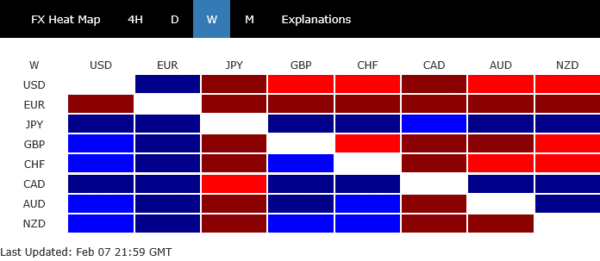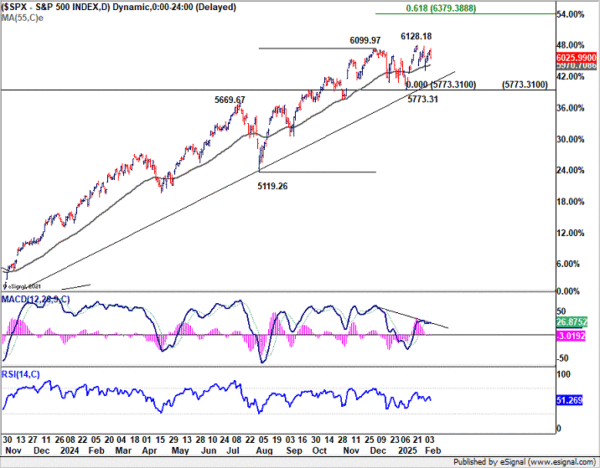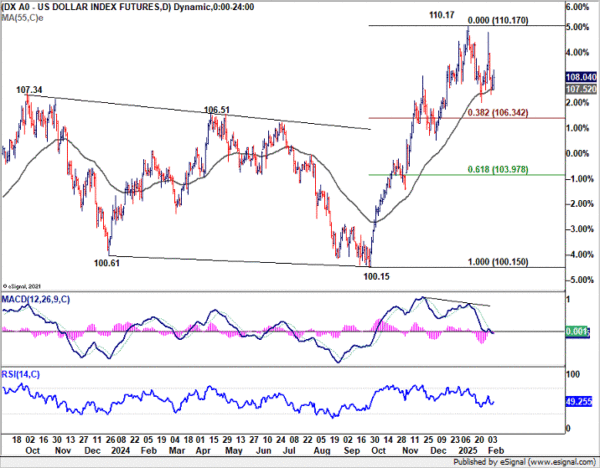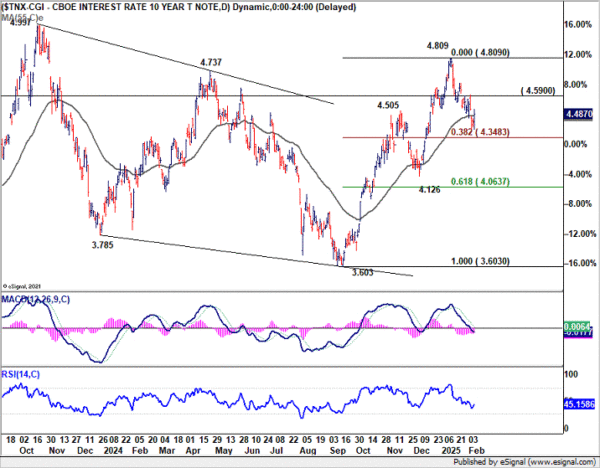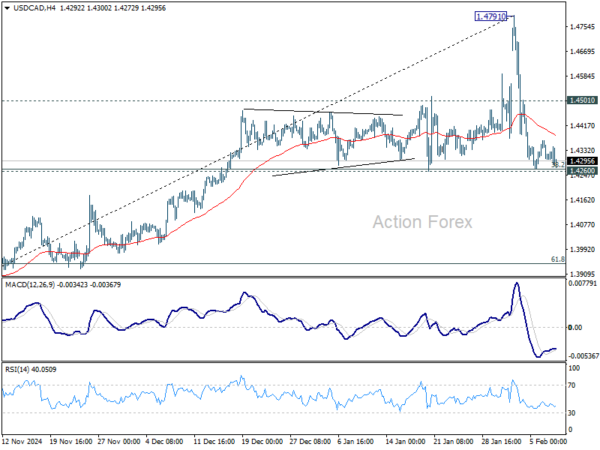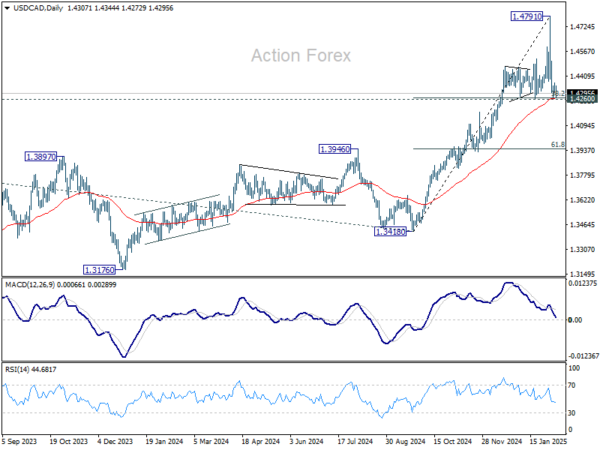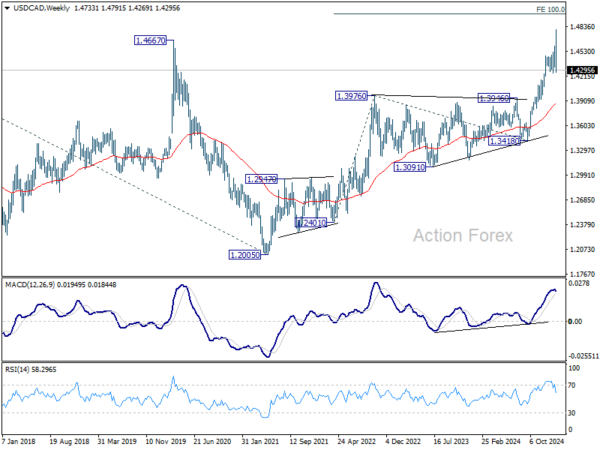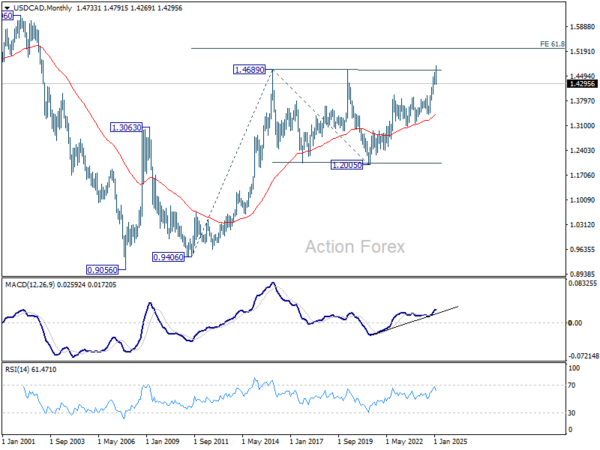Dollar faced significant volatility last week as shifting trade policy signals from the White House left investors scrambling for clarity. Initially, tariffs on Canadian and Mexican imports were imposed, only to be quickly suspended for 30 days following new agreements on border security and fentanyl control. Now, the focus turns to “reciprocal tariffs,” a move that could see the US impose duties equivalent to those faced by American exports in key markets.
While traders hope for clarity once the reciprocal tariffs are officially announced, the risk of another abrupt reversal remains high. The unpredictability of the administration’s trade stance, particularly regarding its approach toward key partners like the European Union, suggests continued volatility in currency markets. Until the full scope of Trump’s trade strategy is revealed, market sentiment is likely to remain fragile, with investors hesitant to commit to a firm direction.
Amid these confusions, Yen stood out as the strongest performer, supported by positive economic data that reinforced expectations of further BoJ rate hikes. Canadian Dollar followed behind, benefiting from a temporary tariff reprieve and stronger-than-expected employment report. Meanwhile, Australian and New Zealand Dollars managed to recover some ground, but their gains were limited by the continued US tariffs on Chinese goods and the lack of any progress in US-China trade negotiations.
On the weaker side, Euro was the worst-performing currency, struggling under the weight of tariff threats. Despite its late-week bounce, Dollar ended the week near the bottom of the performance rankings. British Pound also weakened after the BoE delivered a surprisingly dovish rate cut, while the Swiss Franc was also soft.
Duel Uncertainty of Trade War and Hawkish Fed Outlook in the US
Investors in US financial markets are grappling with two major uncertainties—President Donald Trump’s evolving tariff strategy and Fed’s interest rate outlook. This dual uncertainty has led to volatile but indecisive trading in major equity indices and large price swings in Dollar, reflecting broader confusion in the markets.
Trump’s Tariff Play: Economic Policy or Political Leverage?
The core intention behind Trump’s tariff policies remains unclear. His administration initially imposed 25% tariffs on imports from Canada and Mexico, only to suspend them for 30 days following agreements with both nations on border security and fentanyl control measures. This move suggests that Trump may be using tariffs as a tool for securing non-trade-related concessions rather than purely as an economic strategy. The immediate delay in enforcement highlights that these tariffs could be more of a negotiation tactic than an outright protectionist measure.
However, fresh concerns emerged on Friday when Trump said that the US would announce, in the coming days, “reciprocal tariffs” on a range of trading partners to ensure American exports are treated “evenly.” This move, if implemented broadly, could have far-reaching economic consequences, particularly if the US targets major trade partners like the European Union. Unlike the previous round of tariffs during Trump’s first term, which were primarily aimed at China, this time the scope appears much wider, raising the specter of more extensive trade disruptions.
The biggest risk is that tariffs could become an ongoing feature of US trade policy rather than a temporary bargaining tool. With Trump also eyeing the EU as a target, the outlook for global trade is highly uncertain. For now, investors are clearly staying in wait-and-see mode, monitoring Trump’s next steps closely.
Strong US Job Market to Keep Fed on Hold, Inflation Risks Re-Emerging?
While trade concerns dominate the headlines, the strength of the US labor market has reinforced expectations that Fed will remain in a prolonged pause on rate cuts.
Dallas Fed President Lorie Logan articulated a noteworthy point last week. She argued falling inflation with robust labor market means interest rates are already near neutral. That would leave little room for further easing in the near term. Fed would then stay on hold until there is clear evidence of a labor market slowdown, not just declining inflation.
Friday’s non-farm payroll report added weight to this narrative. While job growth slowed to 143K, falling short of expectations, revisions to previous months were significant, with December’s figure being adjusted upward to 307K. Additionally, the unemployment rate unexpectedly declined from 4.1% to 4.0%, suggesting that the labor market remains resilient. Wage growth also accelerated, with average hourly earnings rising 0.5% mom —above expectations—bringing the annual increase to 4.1%.
Another concerning development in recent data was the sharp rise in consumer inflation expectations. University of Michigan’s Surveys of Consumers revealed that short-term inflation expectations jumped from 3.3% to 4.3%, the highest level since November 2023. Long-term inflation expectations also ticked higher, reaching 3.3%, marking the highest reading since June 2008.
If inflation expectations continue rising alongside strong wage growth, Fed could face renewed pressure to reconsider its monetary policy stance. A scenario where inflation remains stubbornly above target while employment stays strong could force Fed to maintain high rates longer than markets currently anticipate. In an extreme case, policymakers may even have to consider reintroducing rate hikes—an outcome that is not currently priced into the market but remains a potential risk, albeit minor.
S&P 500 Stuck in Range, Upside Appears Limited
Technically, S&P 500’s price actions from 6128.18 (Jan high) are still corrective looking, suggesting larger up trend remains intact. However, even in case of up trend resumption, loss of momentum as seen in D MACD could limit upside at 61.8% projection of 5119.26 to 6099.97 from 5773.31 at 6379.38.
On the other hand, strong break of 55 D EMA (now at 5970.70) would put 5773.31 structural support into focus. Firm break of 5773.31 will argue that a medium term top was already in place, and larger scale correction is underway.
Sideway Trading to Continue in Dollar Index and 10-Year Yield
Dollar Index’s initial spike was capped below 110.17 resistance, and followed by steep pull back. Overall outlook is unchanged that consolidation pattern from 110.17 is still extending. In case of another selloff, downside should be contained by 38.2% retracement of 100.15 to 110.17 at 106.34 to bring rebound. However, firm break of 110.17 is needed to confirm up trend resumption, which is unlikely for the near term. Hence, sideway trading is set to continue for a while.
10-year yield’s fall from 4.809 extended lower last week but recovered notably on Friday to close at 4.487. As long as 38.2% retracement of 3.603 to 4.809 at 4.348 stays intact, price actions from 4.809 are viewed as a corrective pattern. Break of 4.590 will bring stronger rebound. But upside should be limited by 4.809, at least on first attempt. That is, similar to Dollar Index, range trading will likely continue for a while.
EUR/JPY and GBP/JPY Tumble as Yen Rides Rate Expectations and Trade Uncertainty
Yen emerged as a dominant force in the forex markets last week, with EUR/JPY and GBP/JPY among the biggest losers, down -2.7% and -2.3% respectively. The shift was driven by a combination of declining US and European benchmark yields, alongside increasing expectations of further BoJ rate hikes. These factors reinforced the Yen’s bullish momentum and kept both EUR/JPY and GBP/JPY under heavy selling pressure.
BoJ board member Naoki Tamura, the most hawkish voices within the central bank, continued to advocate his view that interest rates should rise to at least 1% by the end of fiscal 2025. His stance gained additional credibility after IMF also backed a gradual rate hike approach, recommending that the policy rate reach the midpoint of 1.5% within the 1-2% neutral range by the end of 2027.
The case for BoJ tightening has been reinforced by strong nominal wage growth, with real wages increasing for a second consecutive month. More importantly, the wage gains are feeding into stronger consumption, a critical factor in sustaining inflation at the central bank’s 2% target. If this trend continues, BoJ will have even more reason to proceed with further hikes.
Meanwhile, Euro came under additional pressure from Trump’s tariff threats. With a formal reciprocal tariff announcement expected soon, the EU is almost certain to be included, raising fears of another prolonged trade conflict. Given the region’s reliance on exports, such a development could have a significant negative impact on Eurozone already sluggish growth prospects, forcing ECB to take a more dovish stance than currently anticipated.
ECB Chief Economist Philip Lane has been advocating for a “middle path” in policy easing, balancing inflation risks with economic headwinds. However, should tariffs materialize, ECB might be forced to accelerate rate cuts to cushion the economy from external shocks
The UK has fared somewhat better as it is not a primary target of Trump’s trade measures. However, BOE’s unexpectedly dovish rate cut last week has left the Pound vulnerable too. Notably, hawkish policymaker Catherine Mann made a surprising U-turn, voting for a 50bps rate cut, a sharp departure from her previous stance. The base case still remains a quarterly 25bps cut throughout 2025 for BoE, but the risk is now tilted slightly toward a more aggressive easing cycle.
Technically, as selloff in EUR/JPY intensified, the development in the next few weeks would be crucial. Attention will be on 100% projection of 100% projection of 166.7 to 156.16 from 164.89 at 154.38, which is close to 154.40 key support.
Firm break there will resume whole pattern from 175.41 medium term top. More importantly, that would make 38.2% retracement of 114.42 to 175.41 at 152.11 key long term fibonacci level vulnerable.
For GBP/JPY, the focus will be on 100% projection of 198.94 to 189.31 from 194.73 at 185.10. Decisive break there could prompt downside acceleration through 180.00 low to resume whole decline from 208.09 medium term top. That would at least put 38.2% retracement of 123.94 to 208.09 at 175.94 as next target.
USD/CAD Weekly Outlook
USD/CAD spiked higher to 1.4791 last week but reversed sharply from there. Nevertheless, downside is contained by 1.4260 cluster support (38.2% retracement of 1.3418 to 1.4791 at 1.4267), which is also close to 55 D EMA (now at 1.4264). There is no sign of reversal yet. Initial bias remains neutral this week first. On the upside, above 1.4501 minor resistance will turn bias back to the upside for stronger rebound. Larger up trend is expected to resume through 1.4791 at a later stage. However, firm break of 1.4260 will indicate that deeper correction is underway.
In the bigger picture, long term up trend is tentatively seen as resuming with breach of 1.4667/89 key resistance zone (2020/2015 highs). Next target is 100% projection of 1.2401 to 1.3976 from 1.3418 at 1.4993. This will remain the favored case as long as 1.3976 resistance turned holds (2022 high), even in case of deep pullback.
In the longer term picture, up trend from 0.9506 (2007 low) is in progress and possibly resuming. Next target is 61.8% projections of 0.9406 to 1.4689 from 1.2005 at 1.5270. While rejection by 1.4689 will delay the bullish case, further rally will remain in favor as long as 55 M EMA (1.3392) holds.

